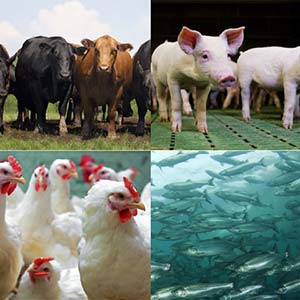Animal protein production is expanding around the world, and increasing competition – among the species for share of consumer wallet and exporters for access to import destinations – is creating many areas of opportunity for both producers and processors, according to RaboResearch’s Animal Protein Outlook for 2018.
 “Rabobank expects animal protein production to increase in all regions, with total production growth once again surpassing the ten-year average. This strong production increase is mainly being driven by Brazil, China, and the US,” said Justin Sherrard, global strategist for animal protein at the Utrecht, Holland-headquartered multinational banking and financial services company.
“Rabobank expects animal protein production to increase in all regions, with total production growth once again surpassing the ten-year average. This strong production increase is mainly being driven by Brazil, China, and the US,” said Justin Sherrard, global strategist for animal protein at the Utrecht, Holland-headquartered multinational banking and financial services company.
Looking at production across species, beef joins pork as a strong contributor to global expansion. It is anticipated that global beef production will expand for a third consecutive year in 2018, while pork production is expected to see another year of significant expansion. Poultry production is also expected to grow, but will be down slightly on 2017.
Impact of Aquaculture
In seafood, aquaculture continues to drive seafood supply growth. Sustainable growth in the seafood industry solely depends on aquaculture, although it is expected that the wild catch sector will recover after El Niño recedes in 2017. Zooming in, the salmon market is recovering, fishmeal prices will stabilize, and the shrimp industry is likely to continue growing.
“The Rabobank trade scorecard for 2018 shows that many countries are looking to increase exports, and this will be a major part of the increased competition we expect in 2018,” said Sherrard.
While specific trade outcomes will also reflect growing demand, access issues and policy decisions, Rabobank expects trade to represent an important area of both opportunity and uncertainty over the coming year. Uncertainty in 2018 will come from the heavy overlay of politics in trade policy – such as the NAFTA negotiation, Brexit and the US-China trade relationship– which is not new but does seem to have become more common; and from biosecurity issues – such as Avian Influenza, African Swine Fever and EHP (a fungal infection in shrimp) – which again appear susceptible to political involvement.
“Trade should be the top-of-mind issue for global animal protein as we head into a new year, and enhancing competitiveness is going to be critical for success,” said Sherrard.
Other Major Issues
Looking beyond markets and trade, Rabobank sees four other issues that will dominate the headlines for animal protein in 2018: increasing, although uneven, industry consolidation; the evolving retail landscape; alternative proteins; and technology.
In food retail, the evolving landscape is one of more channels, more product options, and more velocity, for instance due to blurring retail channels. This will bring new areas of opportunity, such as online food sales in China, and generally present opportunities to strong and agile animal protein supply chains.
Alternative proteins will grow further from their small base and continue to capture consumer interest in innovative food. At the same time, the animal protein production chain, and especially aquaculture, will focus on alternative proteins as an innovative feed ingredient.
When it comes to innovation, technology – and in particular data-driven technology – is starting to deliver value along the animal supply chain, for instance by increased supply chain cost management. Reducing the environmental footprint and addressing social concerns are two very important drivers behind the increase of technology.
Regional outlooks for 2018 are summarized below.
- North America: Production continues to grow. Ongoing expansion across the species increases the dependence on trade, yet access to trade markets will be an area of uncertainty in the new year.
- South America: Production will increase. Brazil and Argentina are set to boost beef production by 5% and 4%, respectively, with Brazil also expanding poultry and pork output.
- EU: Exports are key in a challenging market. Access to export markets is increasingly important for processors, as production rises, while social issues remain top of mind for domestic consumers.
- China: Pork supply will increase, poultry will stay flat. The PRC’s pork market is entering a down cycle, with imports set to rise as structural adjustment continues. Overall poultry supply will be flat, with white bird supply declining and other species rising. Beef supply will grow steadily, with imports being the main driving force.
- Southeast Asia: Production growth will decelerate. Poultry output is tapering off in response to oversupply. Beef demand will continue to be met by imports, with price being the main focus in trade decision making.
- Australia and New Zealand: Beef and lamb production will remain steady. Improved seasonal conditions support Australian producer demand for cattle amid softer export markets, while in New Zealand beef exporters are reliant on continued demand growth in export markets.





